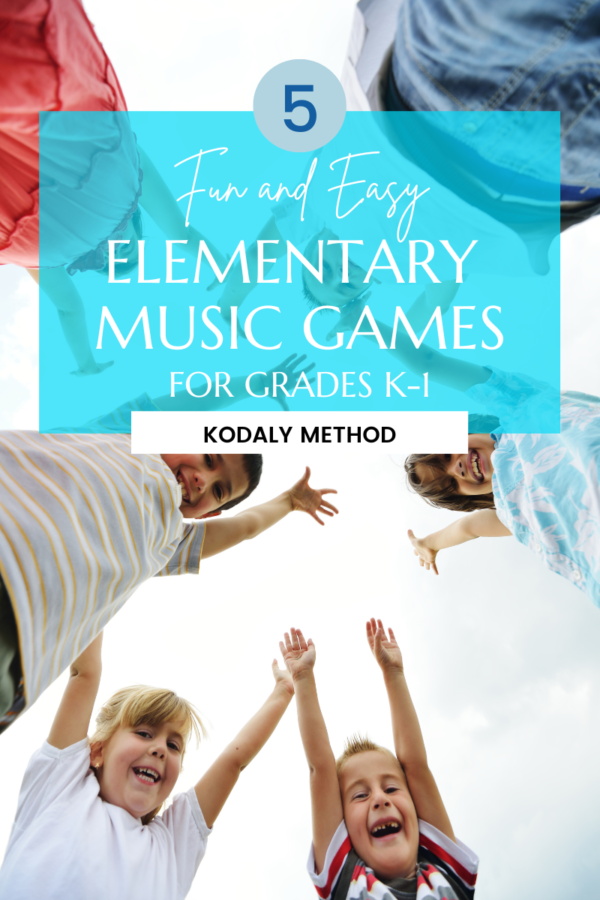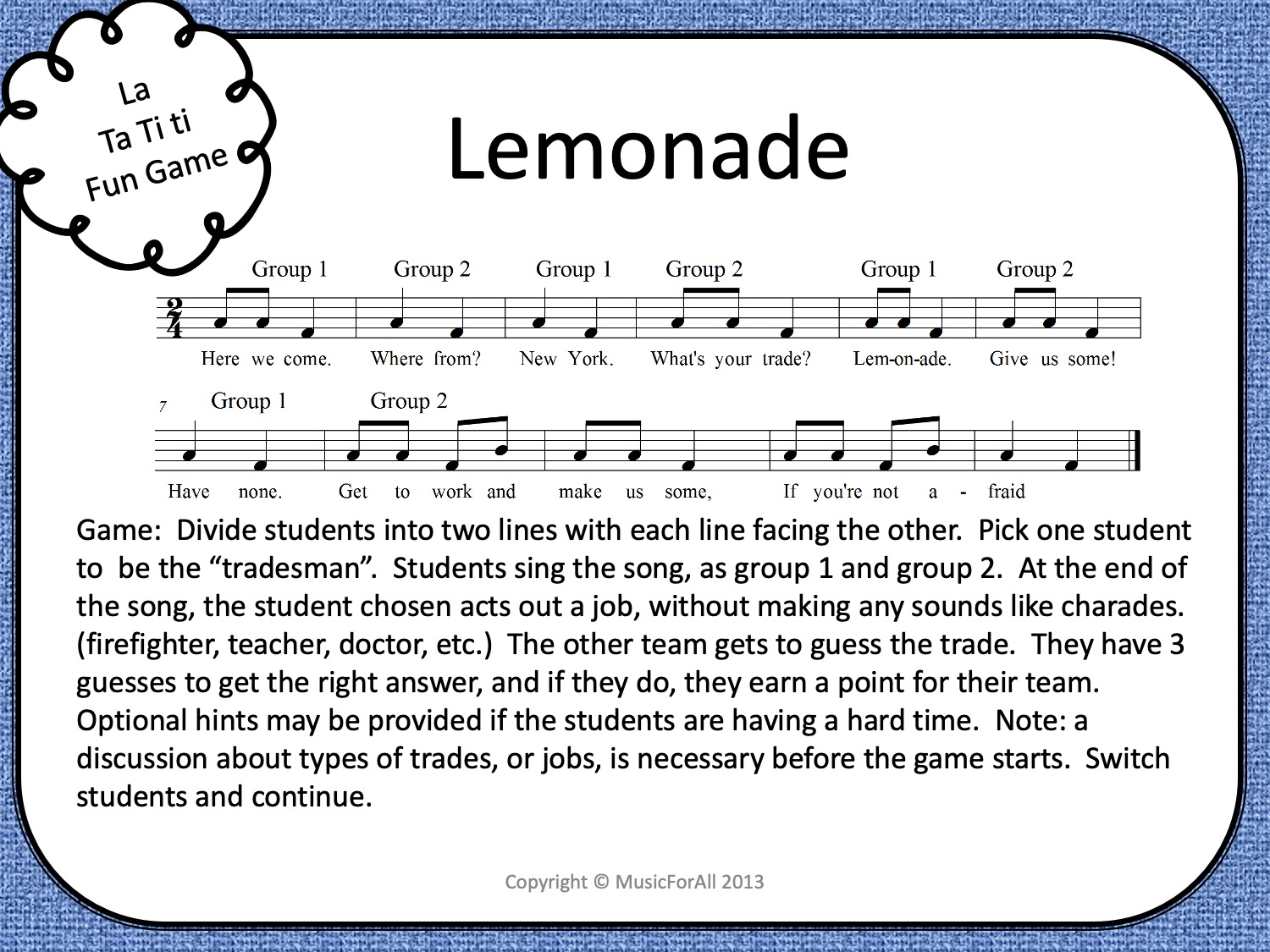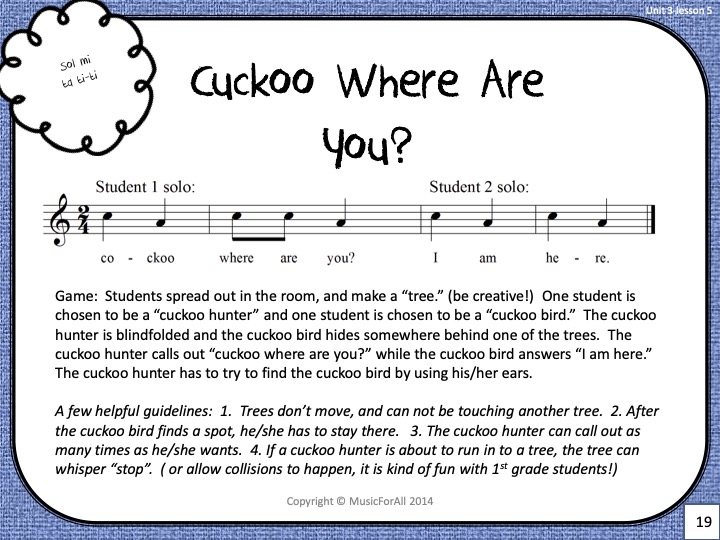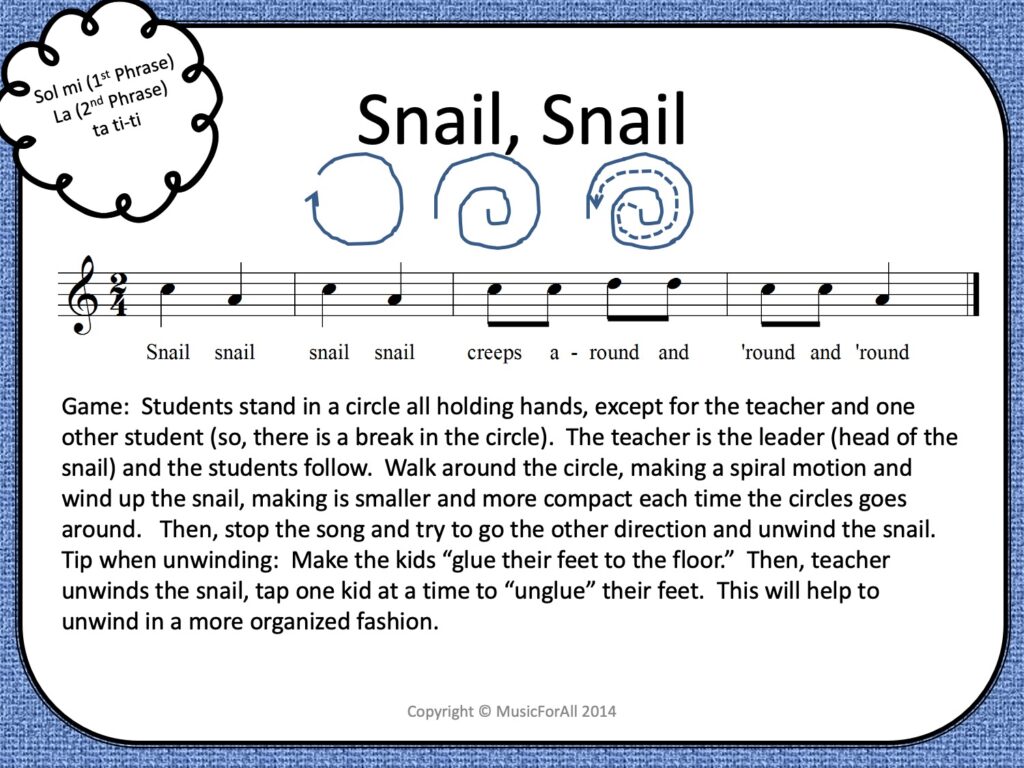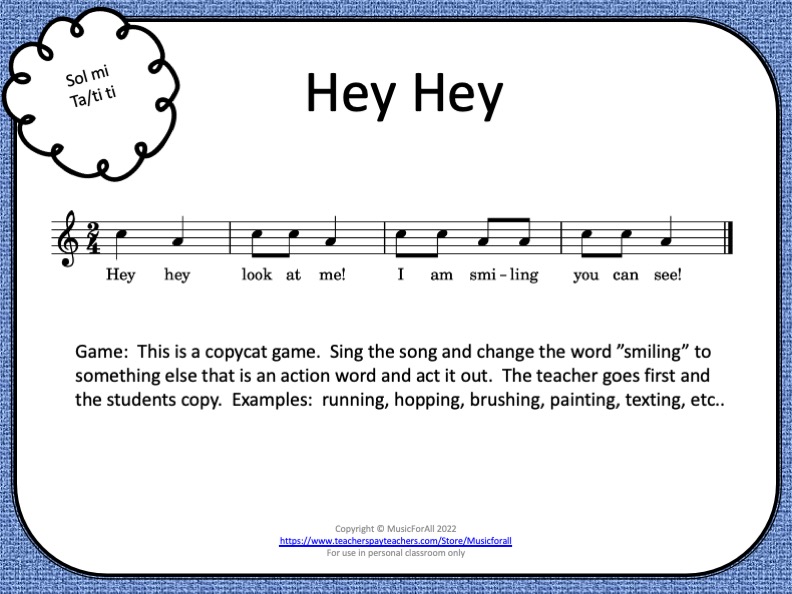What Do Students Love Most about Music Class?
I love playing these elementary music games with my students. The games are the foundation of my curriculum. They are the hook that keeps kids wanting more. They are the reason why students love music class so much. “Are we playing a game today?” It’s the first thing they ask when they enter the door. It’s what they look forward to. It seems like sometimes it’s all they think about! And that’s okay – because playing these singing games with your students is a great way to learn.
5 Reasons to play Kodaly method games in elementary music class
- Games are fun!
- Playing is a natural part of a child’s life.
- Music games give students time to practice singing.
- They help to internalize the melody and rhythm of a song.
- The melody and rhythm from these songs will be used to teach music literacy.
“Play is often talked about as if it were a relief from serious learning. But for children play is serious learning. Play is really the work of childhood.”
– Fred Rogers
5 Fun Elementary Music Games, Grades K-1
1. Lemonade
Music Game directions
Students love to play charades at home, and now they can play it in elementary music class! This is a charades type of game. I have students line up in two groups. I write a name of a job on a dry-erase board and show the group going first so that the other group can’t see the answer. Whichever group is acting first sings first. At the end of the song, the other group gets to shout out answers. This is the fun part – but it is also challenging for first-grade students. Some of the jobs that I have used in the past are gardener, cleaner, construction worker, chef, pilot, etc.. Some that were challenging (in a good way) for my students were: lawyer, uber driver, carpenter, and roofer. Remember… in charades, you are not allowed to talk or make noise. The team acting has to do it completely silently.
Things to watch out for…
One thing that helps the game, in the beginning, is to have a class discussion about trades. Make a class list of all the jobs that students can come up with, and then use the items on this list to choose from when playing the game. I usually only do this the first time playing the game, and after that, they get the hang of it!
Another thing about this game is it seems that my group of kids always wants to shout at the end instead of sing. Be sure to remind them that this is a singing game and they should be using their good singing voices. I will often say “if we can’t sing the song, then we can’t play the game”. It is amazing how this motivates students to try to use their best voices!
Kodaly method Music literacy
If you are new to the Kodaly Method, this is a great song for sol and mi, as well as quarter notes and paired-eighth notes (ta/ ti-ti). The reason I love this song for music literacy is that it has different patterns than most songs we sing.
I use this song when I am preparing sol/mi. Since we are preparing, we show lemons instead of music notes. Later on, we can show this song using actual music notes from the staff.

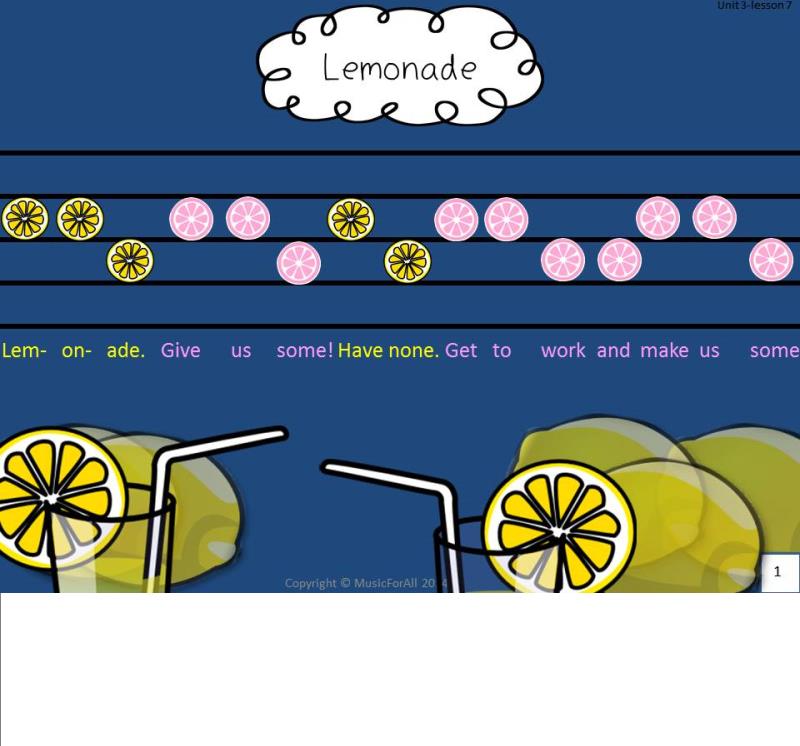
2. Cuckoo
Setting up the game
This is one of my students’ favorite games in elementary music class. First, Pick one student to be the “cuckoo”. Have them come over to their “cage” and stand next to you. Next, tell students to make “trees” in the forest. They can make any shape of a tree – tall and skinny, spread out, twisted, short. But no stumps or logs because we don’t want to trip. In other words – students have to be up on their feet. No laying down. Finally, pick a student to be the “cuckoo finder”. Have that student stand by you and the cuckoo bird.
When you go in this order, it will help students not crowd around the cuckoo bird or the cuckoo hunter. We want the trees to be spread out evenly, so the game works better.
Game Story
One night, the cuckoo owner forgot to close the gate. In the middle of the night, the cuckoo bird escaped and flew into the forest. The cuckoo finder has to go look for the cuckoo bird. But, since it is nighttime, the cuckoo finder is blindfolded. The cuckoo bird hides behind a tree, and the cuckoo finder has to call out, “cuckoo, where are you?”
Music Game directions
The cuckoo finder is blindfolded, and the cuckoo bird goes and hides behind a tree. The finder sings, “cuckoo, where are you,” and the cuckoo bird sings back, “I am here”. The cuckoo finder keeps calling to the bird and has to use its ears to find the bird. Pick two students to go next, and continue the game.
Game rules that work for me
- Trees can’t talk or move. If you do, then you have to sit in a “calm down” until you are ready to follow directions
- Once the cuckoo bird hides, it can’t move.
- the cuckoo finder can sing as many times as they want. The more you sing, the easier it is to find the cuckoo bird
- If the cuckoo finder is about to bump into you, then a tree gets to whisper, “stop”
- Sometimes there is a slight “breeze” in the forest, and a tree can move its arms to allow a bird to get through.
Tip: When picking students for this game. Use a “fair” method, such as picking popsicle sticks from a jar or randomly choosing a child from your roster. Most of the time, I play games for about 5-10 minutes and this is a game that takes a long time to take turns. Typically when I play this game, I tell students that not everyone will get a chance to be the bird or cuckoo bird. But we all have the same chance of going, so it’s fair!
Kodaly Method and Music Literacy
I use this song for sol/mi and ta/ti-ti. It is also a great song for singing because it has solos. Solos are a great way for a child to hear if they are singing in tune.
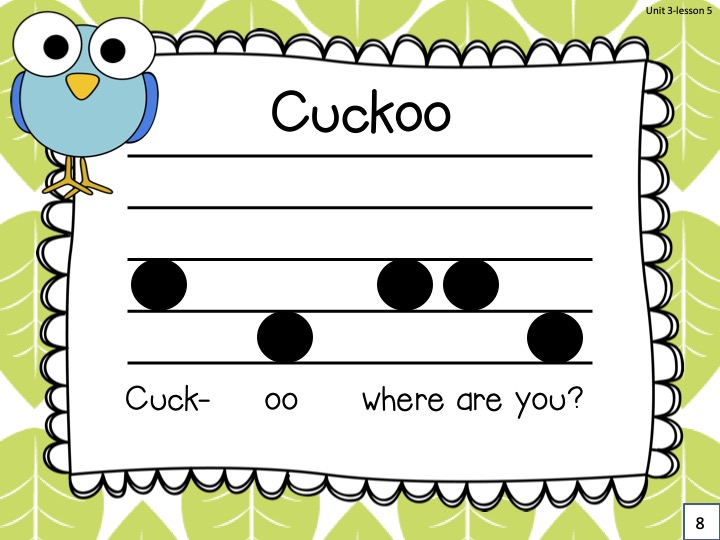
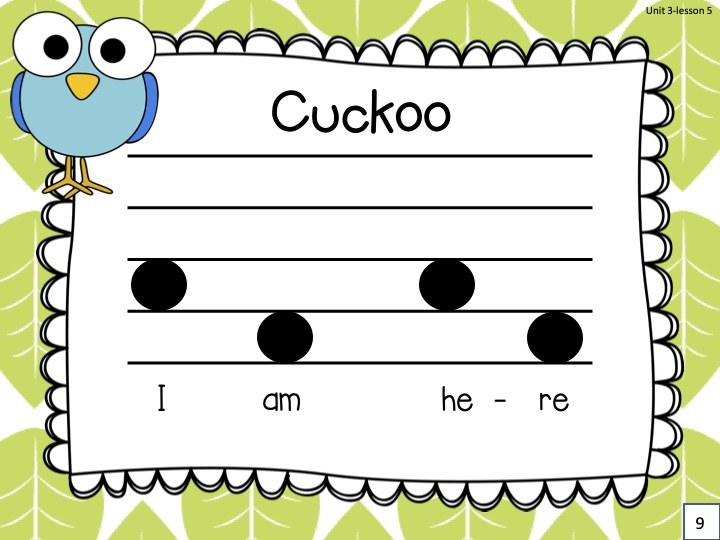
3. Snail Snail
Setting up the game
I love playing this music game with young students and seeing their eyes when they realize that we turned our circle into a snail! Students stand in a circle and hold hands. The teacher is holding hands also. Let go of the student’s hand to the left of you to make a break in the circle. The teacher is the “head” of the snail, and the student to the left of the teacher is the “tail” of the snail.
Music Game Directions
The teacher leads the students around the circle, it winds into a snail shape (see drawing above). When the snail gets all wound up, stop the song. Tell the students to “glue their feet to the floor”. Tell the students that they can only unglue their feet if you tap them on the head. As you start to unwind the snail, tap students on the head to “unglue” their feet.
Tip: go very slow and take small steps!
Alternate Game
The second version of this game is to have the snail go faster, and you can go any direction in the room, like a curvy line. Be careful not to go too fast, though! The students at the end can get “whipped” around, and the force becomes pretty strong. As with any of these games, you, as the teacher, have to decide if the game is right for you based on your space, students, student rapport, and understanding of the game.
Kodaly Method and Music Literacy
As with the other songs, this is a great one for sol/mi, but only if we use the 1st phrase of the song. The general rule that I learned during my Kodaly training was that you can use a phrase for reading/literacy if it has at least 4 beats. However, if we use this song for ta/ti-ti, then we can use the entire song (because it doesn’t contain any other rhythmic concepts that they don’t know yet.

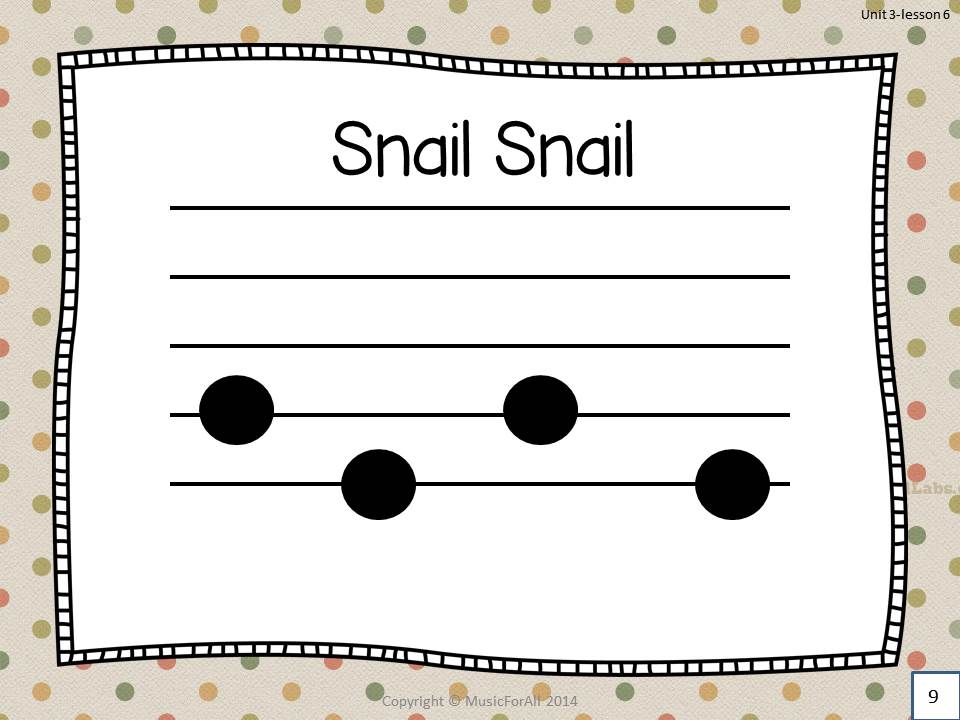
Be sure when you are working on sol/mi to include examples on the space and on the line.
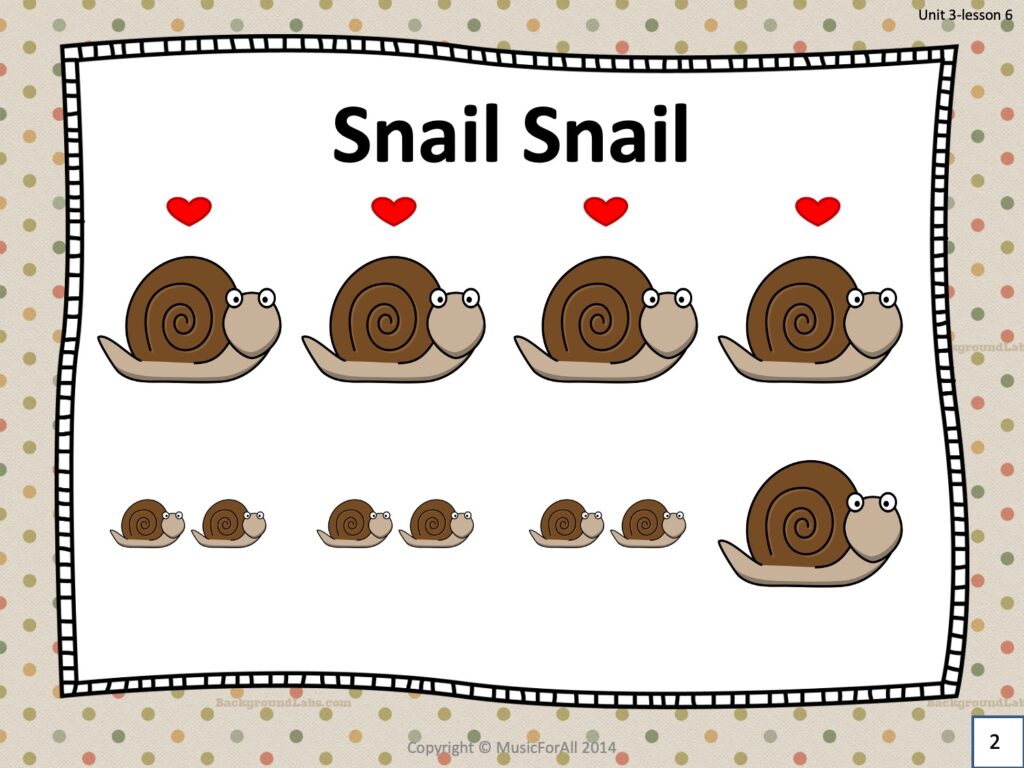
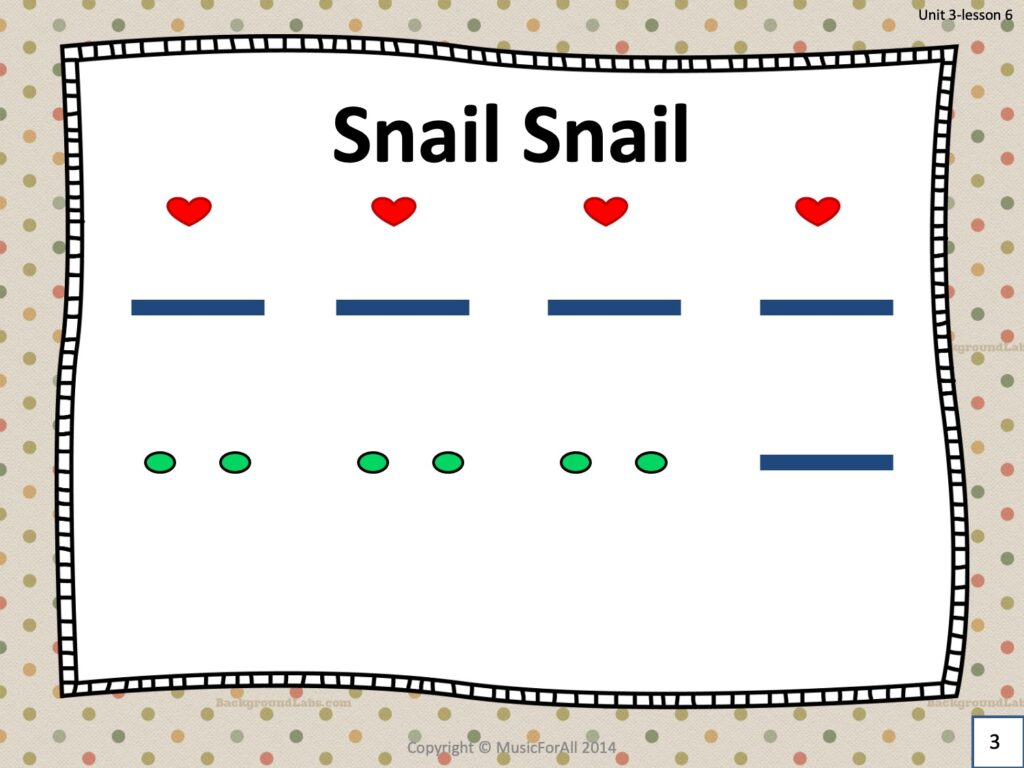
4. Hey, hey
Music Game Directions
Students in elementary love to copycat, and this is a great music game to let them copy you! The teacher sings the song, replaces “smiling” with a different verb, and acts out the motion. The students have to copy and try to mimic the teacher’s movements as closely as possible. Examples: running, jumping, dancing, pointing, cooking, eating, texting, reading, etc.
After you play the game many times and give students lots of examples of how to act, then you can allow students to be leaders. This is great practice for solos. Sometimes students will be eager to volunteer, but then they become up to be a leader, and they can’t think of anything to do. To help with this, create a list of words on the board that students can choose from.
This is a great game to play whenever you need to get the students’ attention for a bit. It gets them up and moving, and it is a great “filler” song if you ever need a few extra minutes to fill in your lesson.
Kodaly Method and Music Literacy
This is a great song for sol/mi and ta/ti-ti.
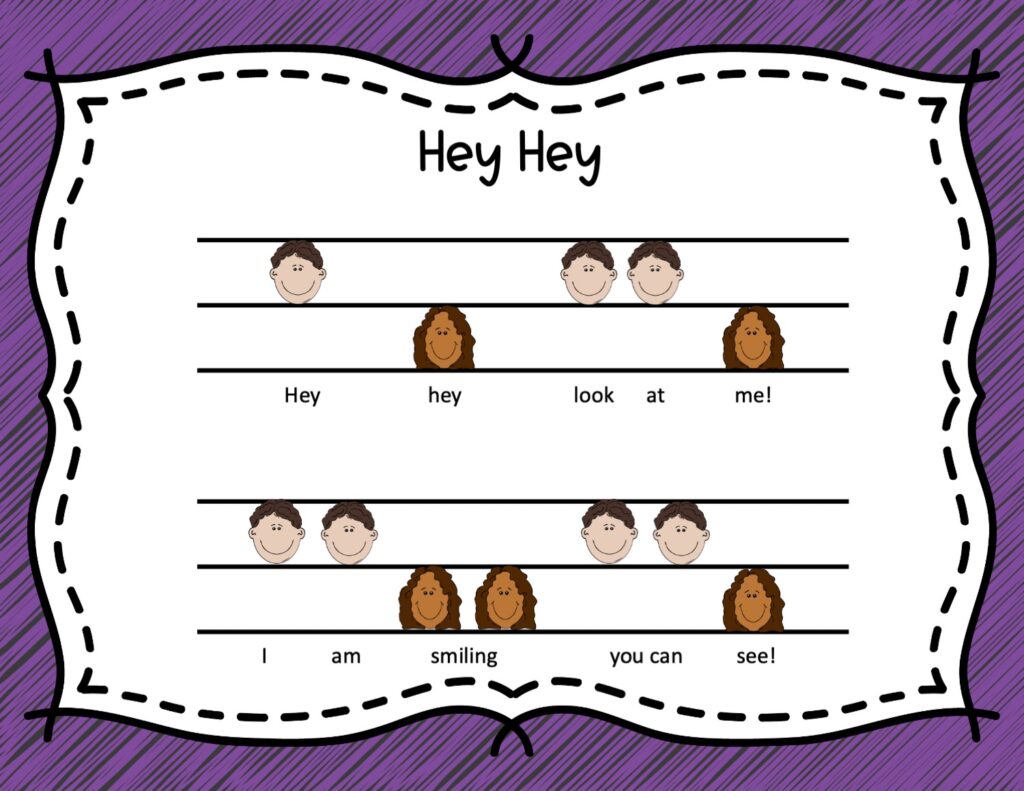

I like showing the melody on a 3-line staff at the beginning of the music reading process. After you play the game several times, sing the song from the board using “highs” and “lows”. Take turns having students come up to the board and point to the melody. Then, show the second slide and do the same thing, but point to the arrows instead.
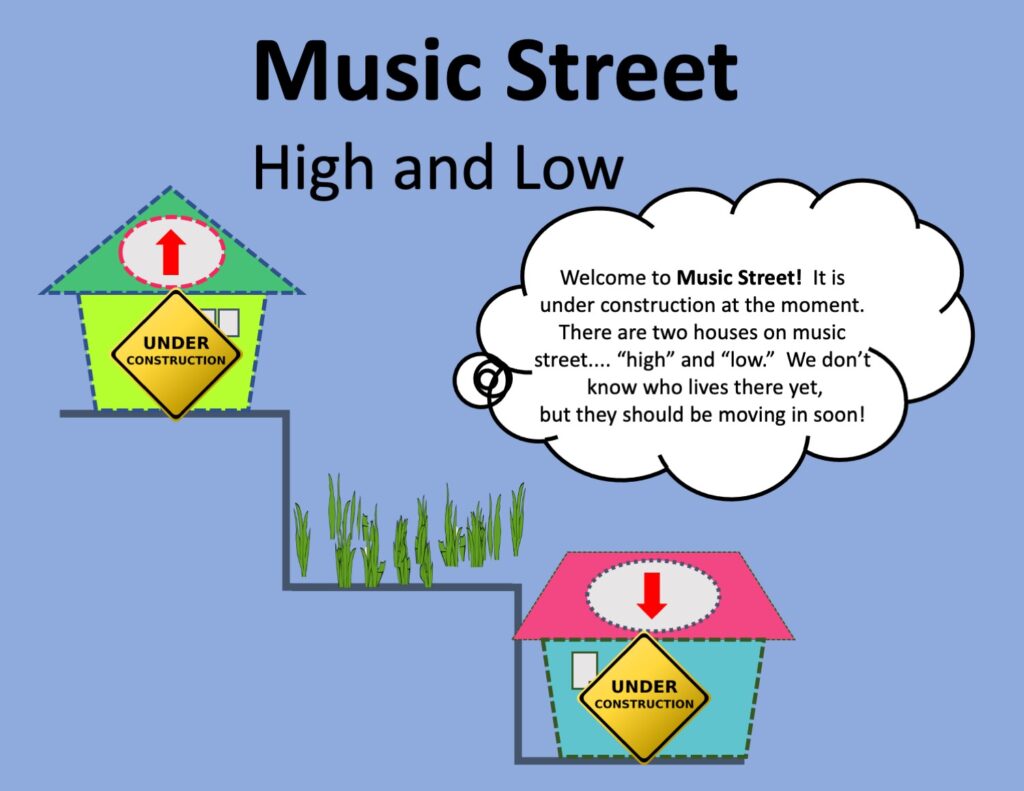
Then will introduce Music Street, a place where music notes live. Music street is under construction, but we will be using this idea throughout the entire curriculum, and we will add solfege syllables to the street as we learn them.
5. Bee bee
Music Game Directions
This is a great game for elementary music class, and 1st-grade students always seem to request it. Here is how you play.
Students stand in a circle, and the teacher is the “bee.” I use a bee hand puppet that a former student teacher gave me as a gift. It is just like the one that my music teacher used when I was a child. Next, say the chant ( with our speaking voices). Tap in the air above students’ heads with a steady beat motion. At the end of the chant, “buzz” three students out. Those students have to go to their chairs or assigned sitting spots. Keep repeating until you have one winner. The end of this game gets so exciting for the students, and they love it! Tip: Have students keep a steady beat motion by bumping their fists together, one above the other.
Kodaly Method and Music Literacy
This is a great chant for comparatives such as high/low, loud/soft, and fast/slow. In my opinion, lots of songs and chants work well for these concepts, but Bee Bee is a great one for high/low because we can imagine the bee flying high or low.
When I’m in the preparation stage for high/low, I use phrases such as “let’s do it like the bee is up in the clouds” or “like the bee is down in a valley.”
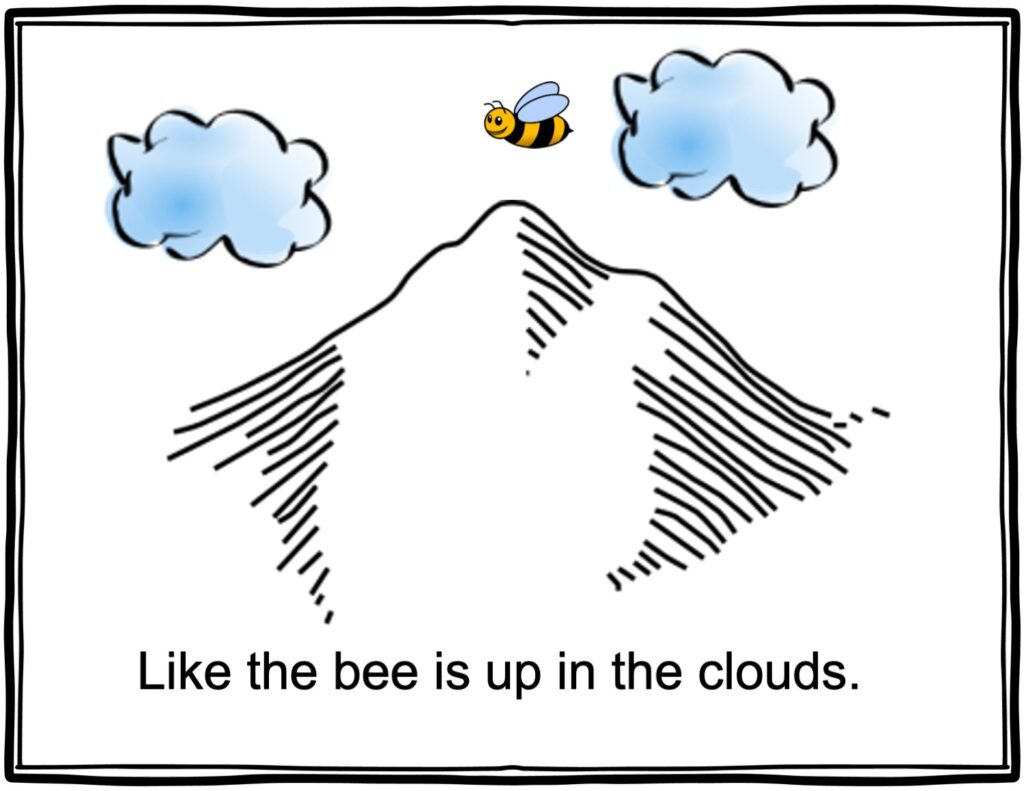
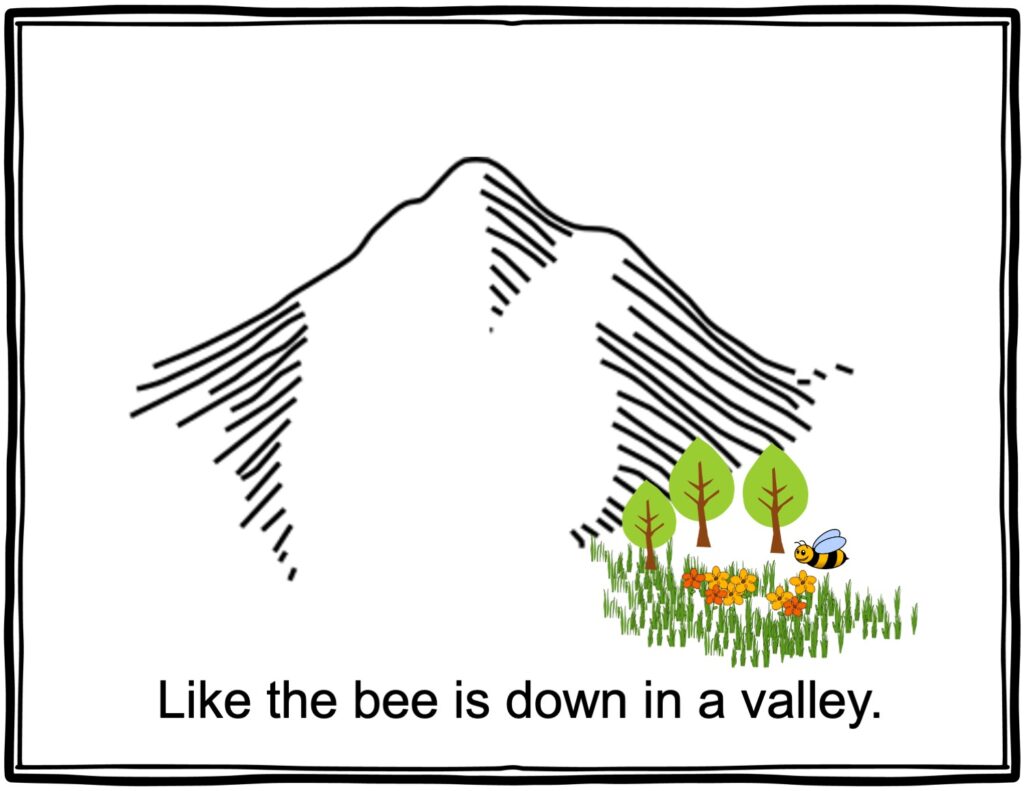
Sometimes it is easy to want to gloss over these early comparatives, but I find it is very helpful to spend a good deal of time working on them. This is especially true for high/low and loud/soft. Many students (and adults) will use these words interchangeably. For example, “crank the music up high” might mean turning the volume louder. And “keep your voice to a low level” might mean using a soft speaking voice during quiet time.
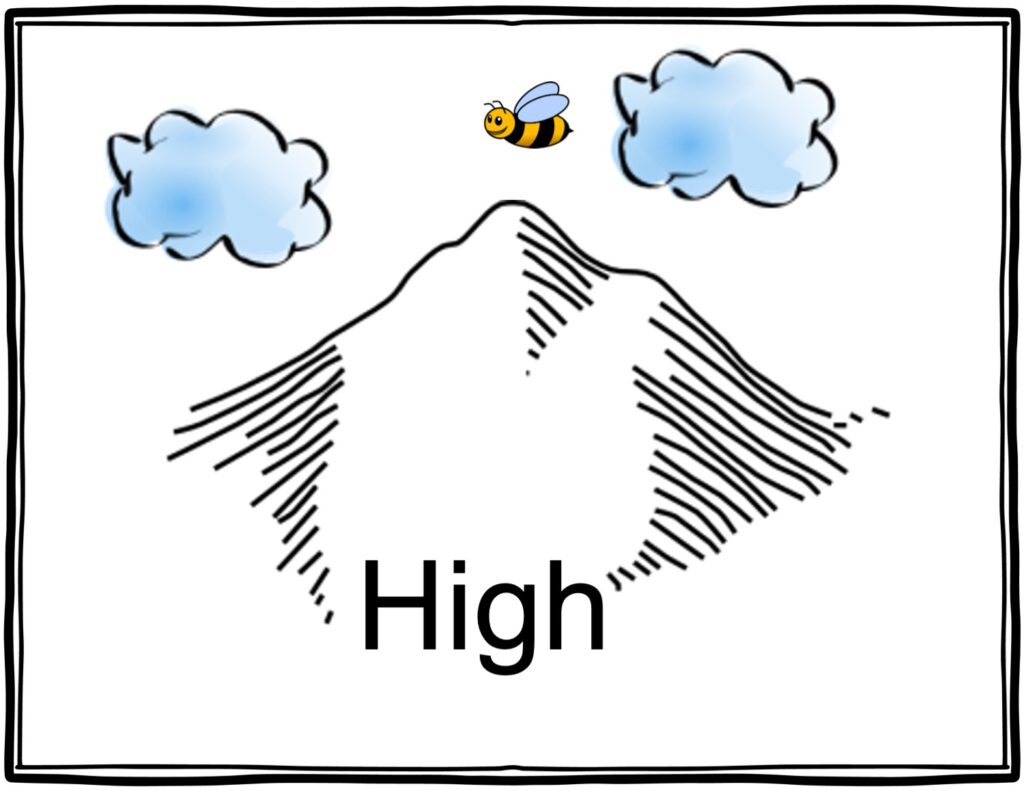

After we spend adequate time preparing a concept, we can move to the present stage, where we tell the students the correct terminology and use it from now on. We immediately enter the practice stage, and we will continue to practice forever (hypothetically).
Steady Beat
Of course, this is also a great chant for a steady beat as well! I like to have the students hold their hands like two “bee hives” by making fists. As you say the chant, have students tap their fists together. This is a great way to quickly assess which students are able to keep a steady beat while saying the words.
Conclusion
I play music games like these with all of my grade levels, and for many more elementary music games, please check out my TPT Store. My store name is MusicForAll (no spaces). I love getting these resources in the hands of teachers so they can help to enrich the lives of your students. Remember – music should be fun! Playing these singing games is a great way to add some joy to your classes while at the same time being the foundation for music literacy.

